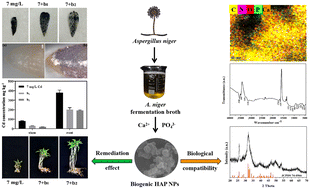Cd stress alleviation in mung-bean seedlings with biogenic hydroxyapatite nanoparticles as ecofriendly remediation agents†
Abstract
Environmentally friendly remediation agents with good biocompatibility have been a research target in heavy-metal pollution remediation in agriculture, which is of great significance for food safety and human health. Disc-shaped biogenic hydroxyapatite (HAP) nanoparticles (NPs) were synthesized using Aspergillus niger fermentation broth as the culture medium, and the remediation effects on Cd contamination were analyzed. The biogenic molecules gave rise to numerous functional groups in the as-obtained HAP NPs. After adding biogenic HAP NPs to the habitat of mung-bean seedlings under Cd pollution, the root cortex was coated tightly by biogenic HAP NPs, and the Cd content in the stems decreased by 33.96–65.66% and 56.07–79.29%, respectively, at low and high dosages of biogenic HAP NPs. Mung-bean development exhibited recovered elongation and biomass accumulation in roots and stems, together with the restored synthesis of photosynthetic pigments. Furthermore, the application of biogenic HAP NPs led to a remarkable reduction of oxidative stress in seedling stems. The intracellular contents of H2O2 and malondialdehyde (MDA) decreased by 42.67–81% and 49.72–68.31%, respectively, under different treatments. The measurement of antioxidant enzyme activities, including superoxide dismutase (SOD), catalase (CAT) and ascorbic acid oxidase (APX), showed that the activities of these enzymes were 1.10–6.34, 1.10–1.53 and 1.00–11.52 times higher than those under Cd stress alone. These results suggested that biogenic HAP NPs diminished the negative effects of Cd on seedling growth, effectively blocked Cd translocation in mung-bean seedlings, and eliminated the oxidative stress triggered by Cd toxicity, which illustrate the advantages of biogenic nanomaterials as ecofriendly remediation agents for heavy-metal contamination in agriculture.

- This article is part of the themed collection: Environmental Remediation


 Please wait while we load your content...
Please wait while we load your content...